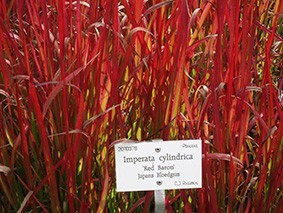“What is a weed? A plant whose virtues have not yet been discovered.” Emerson, 1878.
Weeds are annoying plants which invade and impede our cultivated lands. However, this statement fails to consider the botanical and ecological value of every species of plant life, all of which have their own place in the ecosystem. Using chemicals to eradicate weeds has become normal, and the effects of such chemical pollution and contamination in the environment are now making themselves known.
Weeds can have important botanical, ecological and ethno-botanical value. They help biodiversity, they help to keep a balance in the soil and to enrich organic matter. Above all, for the Lao, as for many other rural Asian populations, a large number of wild plants are used as food, to maintain good health, and are in building projects and rituals.
Such is the case with the weed Imperata cylindrica (L.) Raeusche – ‘gna kha’, in Lao – also known as ‘Alang-alang’.
This grass (Poaceae) appears in the list established by the IUCN (International Union for the Conservation of Nature), of the ‘World’s 100 Most Invasive Grasses’. It is a perennial with strong rhizomes, and its sturdy stems, with linear, silvery-hued, smooth-edged leaves, grow to 30 – 90 cm tall. It forms grassy plains in areas of forest which have been ravaged by fire or toxic defoliants. Farmers and garden lovers complain that it is intrusive and difficult to get rid of, but they acknowledge that it is useful and serves a purpose.
The young leaves provide vital and abundant fodder in areas bereft of trees. When fully-grown, the leaves are used for the roofing of houses. At the beginning of each dry season they are harvested and dried. It is the woman of each family who do the harvesting, usually in locations quite a distance away from home. She will pick the leaves and leave them to dry for five days, then go back to collect them and bring them back to the family house, where she will make ‘tiles’ of leaves. Each tile is approximately one metre long and half a metre wide. The woman will make about twenty tiles per day and it takes 300-400 tiles to make the roof of one house. A group of villagers will help to install the finished roof on bamboo supports and the work is generally done in March or April. The roof lasts for about three years.

Making roof tiles from Imperata cylindrica

Trimming the roof tiles

Putting the tiles on the roof of a traditional bamboo frame house
Importantly, this weed can also be made into a paper pulp which can, if needed, be used instead of the pulp made from the bark of Mulberry Trees (used to make paper). This pulp is a better alternative than that of other similar plants. Finally, the flowering stems of Imperata cylindrica can also be used like Kapok (as padding and stuffing in mattresses and the like).
In traditional forms of medicine, this weed is mostly used to cure skin ailments; its roots are sold in markets and used when bathing children suffering from scabies and various spots or rashes; the flowering stems have healing powers. Also, diuretic and cleansing concoctions, good for the skin and for treating venereal diseases, are made from the roots.
In the Vientiane area, in certain ceremonies, ‘gna kha’ is used symbolically as a force to keep the evil spirits away. In the villages surrounding Luang Prabang, a sprig of ‘gna kha’ is hung on the door of the house to forbid the spirits access.

A sprig of ‘gna kha’ on the door of a house
During the Hmong New Year, in Xiengkhouang and its environs, the festival is centred around a rope made from ‘gna kha’, onto which are threaded rings (also fashioned from ‘gna kha’) each representing a family in the clan.

Imperata cylindrica rope

These so-called weeds also play a role in the creation of country-sides or, on a more modest scale, of our gardens. Horticulturalists, swept up in the Western craze for grasses, have created some very decorative varieties, such as Imperata cylindrica ‘Red Baron’, which provide a colorful addition to our flower beds.


Magawang Mountain in the Iglit-Baco Range
In the Indo-Chinese peninsula, the weed is now looked on as an element of the grasslands, and, as such, it appears in the stories of the populations who live there.
Writing about the Cau Maa of Vietnam, Jean Boulbet recalls the ritual invocation offered each year to the goddess of the rice paddy fields adjacent to the grasslands of Imperata cylindrica:
“I am the scarlet hummingbird that perches on the long Entada vine
crossing the high lands of hardy, tall grasses…..“
Jacques Lemoine translated the moving discourse spoken over the body of a deceased Hmong, which asks that his spirit will finds its way to his ancestors, crossing the ‘horse grass’-covered hills*:
“This is the way traced by your Ancestors…
You go on your way. The ‘horse grass’ before you.
In one hand, you hold your sword, in the other, your crossbow. With your sword and your crossbow, you push the grass aside and clear the way ahead of you. You kneel, your head bowed. And so it is that you reach the place of your Ancestors.”
*Note : ‘horse grass’ is the name given by the Hmong people to Imperata cylindrica (L.) Raeusche
Bibliography:
Ralph Waldo Emerson, 1878, Fortune of the Republic
Jean Boulbet, 1975, Paysans de la forêt, Paris, Ecole Française d’Extrême Orient
Jacques Lemoine, 1983, L’initiation du mort chez les Hmong, Bangkok, Pandora
To follow: Weeds, part 2: Jack in the Bush
By Dr Biba Vilayleck, PTK Resident Ethnobotanist
Translated from the French by Gillian Marshall


